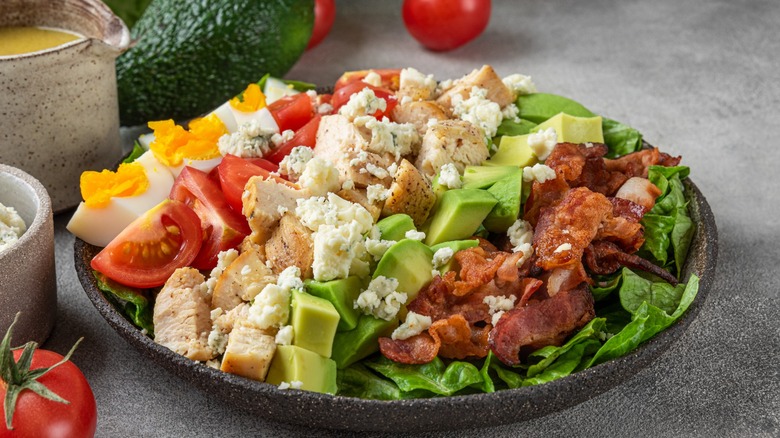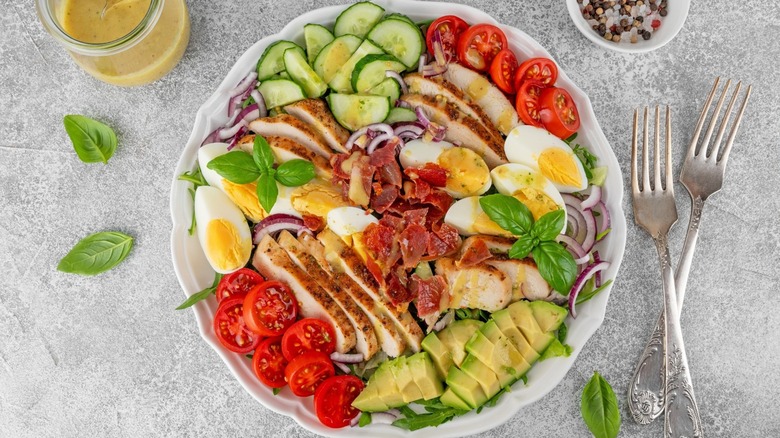The Healthy Part Of You Craves A Cobb Salad, But Here's A Word Of Warning
When trying to eat healthy, a Cobb salad seems like a fantastic choice. After all, the main ingredients in salad are typically fresh vegetables which are packed with nutrients. However, not all salads are created equal, and some may actually detract from your health goals. So before you reach for that Cobb salad, there's something you should know.
Cobb salads are particularly high in calories. The exact number varies depending on whether you prepare a homemade salad or buy one. For reference, a homemade Cobb salad with dressing is an estimated 688 calories, while a Chick-fil-A Cobb salad with grilled chicken is 830 calories. At the end of the day, this healthy food has more calories than a Big Mac.
Of course, calories are necessary! They provide us with energy to keep us going throughout the day. However, each individual's caloric requirements differ and depend on several factors including health, lifestyle, age, and gender. However, some people may have reasons for cutting back, such as losing excess weight per doctor's orders. If this is the case, it's important to understand what you're consuming and how Cobb salads factor into your overall health goals.
Why the calories in a Cobb salad matter
First off, calories are not inherently bad. We need them to not only survive but thrive. However, too much of a good thing can become a negative. Consuming more calories than you burn leads to weight gain and potentially obesity. According to Frontiers in Endocrinology, obesity is a risk factor for diabetes, cardiovascular diseases, and musculoskeletal disorders. So where do you draw the line? Let's explore just how many calories are considered too much.
Healthline claims 2,000 calories is an adequate daily intake for the average adult. However, the outlet admits that this number depends heavily on individual circumstances like current health needs and metabolism. It's best to work with a health professional to understand your personal caloric requirements. However, for the purposes of this article, we'll use the 2,000-calorie model as a frame of reference. When aiming for 2,000 calories and consuming three meals a day, each meal would be around 670 calories. A Cobb salad exceeds this amount, which may put some people in a caloric excess.
If needed, you can easily adjust the caloric content of Cobb salad with simple tweaks. Cooking at home makes it far easier to control what you consume. You might not need to give up your favorite foods to achieve your goals. You just need to know healthier ways to cook these tasty foods! For example, high-fat ingredients like cheese and bacon contain far more calories than lettuce. By cutting these ingredients in half, you can lower your overall caloric intake.
More health factors to consider with Cobb salad
Calories are not the be-all-end-all of health. They are simply one piece of a larger puzzle. And just as salads aren't created equal, calories aren't either.
Health professionals generally promote a nutrient-dense diet, meaning what you consume is packed with health benefits rather than empty calories. To get an idea of which foods we're talking about check out this list of superfoods you can add to meals – because ultimately, eating a nutrient-dense diet maximizes your likelihood of getting all the vitamins and minerals you need to feel your best. And when it comes to nutrients, Cobb salads pack a decent punch. Chicken, eggs, and bacon provide protein, while avocado contributes healthy fats. Meanwhile, tomatoes, onions, and lettuce boast several vitamins and minerals.
However, there are other health factors some individuals may want to consider. One serving of Cobb salad contains an estimated 15 grams of saturated fat, 1,233 milligrams of cholesterol, and 302 milligrams of sodium. These are relatively high numbers, with all of them surpassing half the daily recommended value. So, if you're trying to lower your intake of these items, consider the individual ingredients and tailor your salad appropriately.


